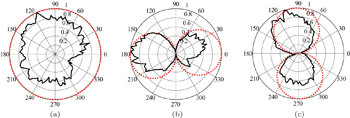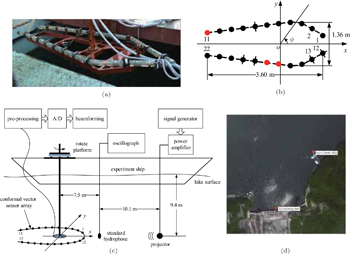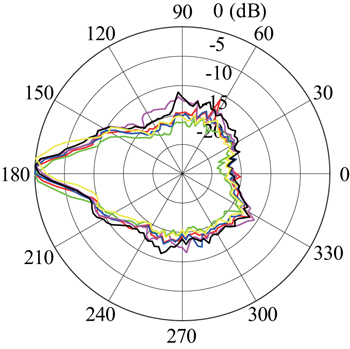† Corresponding author. E-mail:
Project supported by the China Postdoctoral Science Foundation (Grant No. 2016M592782) and the National Natural Science Foundation of China (Grant Nos. 11274253 and 11604259).
An acoustic vector sensor can measure the components of particle velocity and the acoustic pressure at the same point simultaneously, which provides a larger array gain against the ambient noise and a higher angular resolution than the omnidirectional pressure sensor. This paper presents an experimental study of array gain for a conformal acoustic vector sensor array in a practical environment. First, the manifold vector is calculated using the real measured data so that the effects of array mismatches can be minimized. Second, an optimal beamformer with a specific spatial response on the basis of the stable directivity of the ambient noise is designed, which can effectively suppress the ambient noise. Experimental results show that this beamformer for the conformal acoustic vector sensor array provides good signal-to-noise ratio enhancement and is more advantageous than the delay-and-sum and minimum variance distortionless response beamformers.
Vector sensors can make use of more available acoustic information than the scalar pressure sensors (e.g., hydrophones), because they can measure the components of particle velocity and the acoustic pressure at the same point simultaneously.[1–3] Consequently, the performance of a vector sensor array in terms of signal-to-noise ratio (SNR) enhancement, directivity, and localization accuracy, will be superior to that of the same aperture array consisting of scalar pressure sensors. Because the advantages are attractive, the vector sensor technology has grown rapidly in recent decades and it has been applied in many fields such as communication, geo-acoustic inversion, underwater imaging, and so on.[4–7] As the signal processing techniques of the vector sensor array can be included into the classical theoretical framework of scalar pressure sensor array, the existing beamforming methods and direction-of-arrival (DOA) estimation algorithms can be extended to vector sensor arrays.[1,8–11]
Array gain (AG) is defined as the difference between SNR of the output signal and SNR of the input signal of an array, which is an important parameter for measuring the detection performance of the array. When the source signal is a plane wave and the noise field is isotropic, the AG reduces to the directivity factor (DF). Cray and Nuttall[12] provided detailed calculations of the DFs of vector sensors and vector-sensing linear arrays and they also presented some comparisons with the scalar-sensing linear arrays. D’Spain et al.[13] analyzed the optimal AG and detection performance of vector sensor line arrays in a homogeneous, isotropic noise field. It is shown that vector sensors and vector sensor arrays can also provide superdirectivity or supergain in constraint of miniaturized aperture, but the basic principle is different from that for scalar pressure sensor arrays.[14–16] Actually, the knowledge of the correlation structure of the noise always plays an important role in evaluating AG for a sensor array in a practical environment. Some models of the correlation structure under various environment assumptions have been developed for vector sensor arrays, which are useful to analyze the system performance before deployment.[17] However, the assumptions of the environment noise are not always in accordance with practical situation and the theoretical calculations will be sometimes not suitable, even degrade the performance of beamforming methods. For a specific array, the experimental measure is still an essential and direct way to evaluate its capability. In Ref. [18], the results of the minimum variance distortionless response (MVDR) method applying to process the actual data collected by the DIFAR array are presented. Wettergren and Traweek[19] studied the detection performance of a conformal velocity sonar array using a method of optimizing shading weights of the conventional beamformer. Some experimental results are also presented to demonstrate the feasibility of the proposed method. However, most of the previous works in relation to vector sensor arrays are limited to linear configurations, and the researches on the other type of vector sensor arrays are not sufficient.
This paper presents a detailed study of an experimental conformal acoustic vector sensor array in a practical environment, with particular focus on its AG. First, the manifold vector is calculated using the real measured data so that the effects of array mismatches can be minimized. Second, an optimal beamformer with a specific spatial response is designed using a direct optimization method, which can effectively suppress the ambient noise and improve SNR. The delay-and-sum (DAS) and MVDR beamformers are also designed for comparison. The weighting vectors of these beamformers are all calculated using the obtained manifold vector. The AGs of these different methods are calculated using experimental data and a detailed comparison is provided.
An acoustic vector sensor simultaneously measures the components of pressure and two or three orthogonal particle velocities at the same point, which can be written as


Let

The experimental conformal array shown in Fig.
The experiment was carried out in a lake located at east China. As shown in Fig.
In the experiment, the array was rotated from 0° to 360° with a step of 3° in the horizontal plane to receive the signals, which is equivalent to the situation in which the signals were incident from these different directions. After the pre-processing, the received signals were sampled by A/D converters and the sample frequency was 16 kHz. The data from A/D converters were saved to a computer and processed off-line. The real manifold vectors
The amplitude responses of the 8th and 19th sensors at a frequency of 3 kHz are shown in Figs.
 | Fig. 2. Theoretical (dotted line) and practical (solid line) amplitude responses of the 8th sensor. (a) Pressure channel. (b) Velocity channel 1. (c) Velocity channel 2. |
 | Fig. 3. Theoretical (dotted line) and practical (solid line) amplitude responses of the 19th sensor. (a) Pressure channel. (b) Velocity channel 1. (c) Velocity channel 2. |
The directivity of ambient noise can be estimated using the MVDR method. The spatial spectrum is calculated using the following equation:[1]

The noise covariance matrix

The obtained noise spatial directivity is shown in Fig.
One of the methods than can reduce the effect of this anisotropic ambient noise field in the experiment is to design a suitable beamformer that can minimize the responses in ϕ ∈ [150°,210°] subject to some other constraints. The desired beamformer in this paper can be formulated as the following direct optimization problem:



The beampatterns in Fig.


The mainlobes of the three beampatterns in Fig.
Three LFM signals with different input SNRs (which are spaced by 10 dB in turn) were transmitted for the purpose of evaluating the potential for AG enhancement of this conformal vector sensor array, and these signals were all incident from the direction of (90°,0°) in the experiment. Since the center frequency is 2.9 kHz and bandwidth is 200 Hz, the transmitted signals can be regarded as narrow-band signals. The beampatterns can be obtained using the weighting vectors calculated at the frequency of 3 kHz using the above-mentioned methods. Although this frequency is a little different from the signal center frequency, the effects are limited which are neglected. The signals received by the pressure channel of the 12th vector sensor are shown in Fig.
 | Fig. 6. Experimental results. (a) Signals received by the pressure channel of the 12th vector sensor. (b) Output signals of different beamformers corresponding to signal 1. |
After the beamforming procedure, the output SNRs of different beamforming methods can be calculated using the following equation:



| Table 1. AGs of different methods. . |
Because more information from the velocity channels is used, the DAS AGs computed using the data of three channels are larger than those obtained only using the data of pressure channels. Therefore, the vector sensor array can achieve higher AGs than the scalar sensor array with the same array size. As shown in Table
An experimental conformal array consisting of 22 vector sensors is designed, and its AG in a practical environment is studied in this paper. The manifold vector is calculated using the real measured data in the experiment so that the effects of array mismatches can be minimized. Then, the direct optimization, DAS, and MVDR beamformers are designed, and their weighting vectors are all calculated using the above-obtained manifold vector. Because the ambient noise shows a stable directivity, the direct optimization beamformer is deliberately designed to have a specific responese so that it can effectively suppress the ambient noise and improve SNR. The AGs of these different methods are calculated using experimental data and the results show that the direct optimization beamformer provides good SNR enhancement and has more advantages than the DAS and MVDR beamformers.
| 1 | |
| 2 | |
| 3 | |
| 4 | |
| 5 | |
| 6 | |
| 7 | |
| 8 | |
| 9 | |
| 10 | |
| 11 | |
| 12 | |
| 13 | |
| 14 | |
| 15 | |
| 16 | |
| 17 | |
| 18 | |
| 19 | |
| 20 | |
| 21 |





